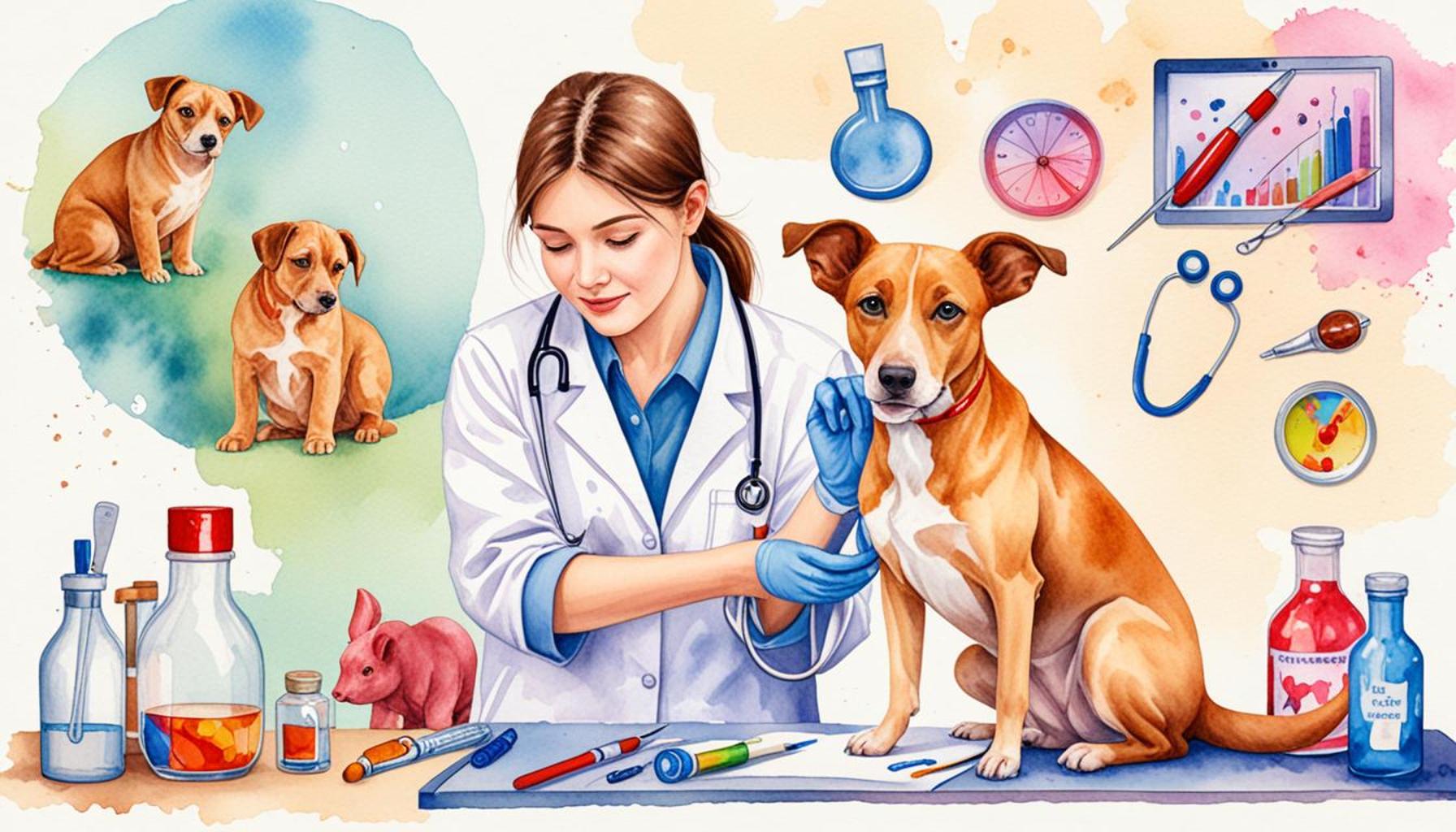How to Identify Signs of Common Diseases in Dogs and Cats

The Importance of Proactive Health Monitoring
Caring for our furry friends goes beyond regular feeding and grooming. Identifying the early signs of diseases in dogs and cats can be crucial for their well-being and longevity. Much like humans, pets can exhibit symptoms that may indicate underlying health issues. Just as we schedule annual health checkups to monitor our health, our pets also require similar attention and care.
Common diseases can present themselves in a myriad of ways. Here are some key signs to monitor:
- Unexplained Weight Loss: This could signal metabolic disorders or even cancer. For instance, a sudden loss of weight in a cat could indicate hyperthyroidism, a common condition in older felines, while dogs may exhibit weight loss due to diabetes or gastrointestinal issues.
- Changes in Appetite: A sudden increase or decrease can be alarming. Dogs that suddenly lose interest in food might be suffering from dental issues or infections, while excessive eating could indicate behavioral problems or even conditions like hyperadrenocorticism (Cushing’s disease).
- Behavioral Changes: Increased aggression or withdrawal may indicate pain or distress. A normally social cat becoming reclusive, for example, could suggest discomfort or illness. Similarly, dogs that exhibit signs of anxiety, such as excessive barking or pacing, may require veterinary evaluation.
- Grooming Habits: Excessive licking or neglecting grooming can be a sign of skin issues or anxiety problems. Dogs with allergies might lick their paws constantly, while cats that stop grooming may have dental pain or other health concerns.
- Frequent Vomiting or Diarrhea: Digestive problems should be assessed promptly. Occasional vomiting could be nothing serious, but frequent occurrences may signify conditions like pancreatitis or infections that require immediate veterinary intervention.
Many pet owners may not recognize these signs until they have escalated into serious conditions. For example, a simple change in a pet’s weight could be overlooked until the issue becomes critical. As responsible guardians, it is imperative to stay vigilant and proactive. Regular vet check-ups combined with a keen eye for subtle health changes can undeniably make a difference in your pet’s life.
In the United States, there are also resources available, such as the American Veterinary Medical Association, which provides guidance on pet health and preventative care. Websites like these can offer your pet an added layer of security through informative content.
In this article, we will delve deeper into the common diseases affecting dogs and cats, their symptoms, and how to ensure your pets receive timely care. This exploration is essential for all pet owners who want to provide the best possible life for their companions.
DISCOVER MORE: Click here to uncover the importance of balanced nutrition for your pets
Recognizing Early Symptoms in Your Pets
As beloved members of our families, detection of signs of common diseases in dogs and cats is essential to maintaining their health and happiness. Just like humans, pets may exhibit early warning signs that often anchor deeper health concerns. Understanding these clues can foster timely intervention and ultimately improve the quality of life for our four-legged companions.
Attention to detail is paramount. Here are some common signs that pet owners should be vigilant about:
- Strange Thirst: An increase in thirst and urination could be indicative of diabetes or kidney disease. If your normally hydrated dog suddenly drinks excessively or if your cat frequently leaves a trail of puddles in the house, it’s time to pay a visit to the vet.
- Labored Breathing: If you notice your pet has difficulty breathing or is panting excessively, it could be a sign of respiratory issues, such as asthma in cats or heart disease in dogs. Dogs, especially those with flat faces (like Bulldogs or Pugs), may be more prone to these issues.
- Changes in Coat Condition: A healthy fur coat is a reflection of an animal’s overall health. Dullness, thinning fur, or excessive shedding can be warning signs of ailments such as allergies, hormonal imbalances, or nutritional deficiencies.
- Abnormal Lumps or Bumps: While not all lumps are malignant, any noticeable changes in your pet’s skin, from new growths to changes in existing lumps, should be examined. Early detection can be crucial, as some tumors may develop rapidly.
- Changes in Mobility: If your pet is less eager to engage in play or takes longer to stand up, it may be a sign of conditions like arthritis, which is relatively common in older pets. Monitoring these physical changes can lead to more active and pain-free living for your furry friend.
Being proactive in observing these signs can mean the difference between a routine treatment and a serious health crisis. For example, increased thirst and urination may seem benign initially, but can quickly escalate into more severe conditions without intervention. Pet owners should routinely assess these changes and communicate them to their veterinarian during regular health checkups.
Additionally, technology can assist in monitoring our pets’ health over time. Devices like pet health trackers can provide insights into your dog’s activity levels and even alert you to changes in behavior that may indicate illness. In the United States, numerous veterinary services also offer telemedicine consultations, allowing you to discuss your concerns remotely.
In the following sections, we will explore specific diseases affecting dogs and cats, their unique symptoms, and the steps you can take to ensure your pet receives the timely care they require. Knowledge is power, and staying informed about your pet’s health can lead to a longer and healthier life for your furry companions.
| Category | Key Features |
|---|---|
| Behavioral Changes | Sudden aggression, withdrawal, or lethargy may signal underlying health issues. |
| Physical Symptoms | Signs like coughing, vomiting, or changes in appetite can point to serious conditions. |
| Skin Conditions | Rashes, hair loss, and itching are common symptoms to be investigated. |
| Chronic Conditions | Diabetes and kidney disease present unique signs in both dogs and cats, needing prompt attention. |
As a pet owner, it’s crucial to remain vigilant in observing your dog or cat’s health. Monitoring behavioral changes is key; for instance, if your usually energetic pup begins to display signs of lethargy, it may indicate discomfort or illness. Furthermore, keep an eye on physical symptoms. Occasional coughing or loss of appetite could hint at respiratory or gastrointestinal problems, respectively. Also, do not overlook any emerging skin conditions; persistent itching or bald patches can be symptomatic of allergies, parasites, or even infections. In elderly pets, pay particular attention to the signs of chronic conditions. For example, indicators of diabetes in cats or dogs include excessive thirst and frequent urination, which require a veterinarian’s assessment to maintain your pet’s quality of life effectively. These steps not only enhance well-being but also pave the way for timely interventions, safeguarding your furry family members.
DISCOVER MORE: Click here for essential tips
Understanding Specific Diseases and Their Indicators
Recognizing signs of illness is only part of the equation; understanding the specific diseases that affect dogs and cats is crucial for responsible pet ownership. Many common diseases present unique symptoms, and early detection can enhance treatment outcomes significantly.
Among the prevalent health issues, canine parvovirus stands out as a critical concern, particularly for unvaccinated puppies. Symptoms like severe vomiting, diarrhea, and lethargy can manifest swiftly and should not be ignored. Parvovirus is highly contagious and can lead to death if not treated promptly. Affected dogs may also exhibit signs of severe abdominal pain; thus, a quick trip to the veterinarian can be lifesaving.
Similarly, feline leukemia virus (FeLV) represents a grave threat to cats. This virus can suppress their immune systems, leading to secondary infections. Symptoms often include weight loss, lethargy, and persistent fever. For cats that spend time outdoors or come into contact with other felines, ensuring they are vaccinated against FeLV is imperative. Regular blood tests can help detect this virus before its effects become apparent.
Another common ailment, especially in older pets, is hypothyroidism in dogs, characterized by symptoms like lethargy, weight gain, and increased sensitivity to cold. In contrast, cats may suffer from hyperthyroidism, which often presents itself through weight loss, excessive vocalization, and hyperactivity. Both conditions can be managed with appropriate medications, but timely identification is key.
Furthermore, dental disease is frequently overlooked yet can significantly impact overall health. Symptoms such as bad breath, difficulty eating, or pawing at the mouth may suggest periodontal disease, which can lead to systemic infections if bacteria enter the bloodstream. Regular dental check-ups and cleanings are essential to prevent these issues and ensure your pet’s well-being.
Allergies are another common ailment that can affect both dogs and cats, often presenting as itching, redness, or ear infections. Environmental factors such as pollen, dust mites, or certain food ingredients can trigger allergic reactions. Pet owners should pay attention to these symptoms, especially during seasonal shifts, and consult their veterinarian for appropriate allergy testing and treatment options.
In addition to monitoring physical signs, a shift in behavior can also be telling. Dogs may hide, avoid interaction, or seem unusually aggressive when in pain, whereas cats might withdraw or display litter box issues. Keeping an open line of communication with your veterinarian about these behavioral changes is crucial as they can provide insights that may not be immediately connected to physical ailments.
Lastly, staying updated on vaccination schedules and regular health screenings is integral to preventing many of these diseases. Many veterinary clinics in the United States offer packages that include vaccinations, older pet check-ups, and blood work tailored to your pet’s age and breed, helping to catch issues before they manifest into severe health problems.
LEARN MORE: Click here to discover the benefits of balanced nutrition for your pet’s health
Conclusion: Empowering Pet Owners for Better Health
In conclusion, the health and well-being of our pets should always be a top priority. By learning how to identify signs of common diseases in dogs and cats, pet owners can play a crucial role in maintaining their beloved companions’ quality of life. Recognizing symptoms such as unexplained weight loss, persistent vomiting, or changes in behavior is essential in allowing for early intervention and effective treatment.
Understanding the distinct characteristics of diseases like canine parvovirus or feline leukemia can further enhance your ability to act swiftly when issues arise. Regular check-ups, vaccinations, and open communication with your veterinarian are indispensable components of a proactive health strategy. Staying informed about your pet’s breed-specific health risks and age-related concerns provides an additional layer of protection against the unforeseen onset of illnesses.
Moreover, don’t underestimate the impact of preventive care, including dental hygiene and allergy management. Incorporating these elements into your pet care routine can safeguard against chronic conditions that may affect your furry friend’s well-being over time. Remember, being observant and informed empowers you not only to recognize symptoms but also to take timely action, ultimately ensuring a happier, healthier life for your cherished pets.
As stewards of their health, let us commit to broadening our knowledge on common diseases and their signs, fostering a vibrant community of informed pet parents dedicated to the wellness of our furry companions.


